Anti-reflection Picture Framing Glass – Part 2
On invisible things, and those that claim to be
Just because you don’t see something doesn’t mean it isn’t there. Some of the most wonderful things in the world are invisible. Trusting in invisible things makes them more powerful and wondrous. ― Kelly Barnhill, The Girl Who Drank the Moon
Introduction
This is the second installment to “The Framing Glass” article, which delves into new 99% UV filtering anti-reflective (AR) glass and comparisons of more AR framing glass from Schott, Guardian, Flabeg and Luxar, which were not included in the first article.
Since January 2016, picture framers have been blessed with two exciting new developments. Groglass announced a brand new 99% UV filtering AR glass, with no ripples in the optical coatings, called Artglass UV 99. Tru Vue also launched an updated Museum Glass product, which unlike the earlier product, also has ‘no ripple or “orange peel” effect on [the] glass surface’.
Interference vs Absorptive UV coatings
Both Artglass UV 99 and Museum Glass employ a UV absorptive coating on one side of the sheet, and then AR coatings are applied to both sides. Since the UV filtering coating is an absorptive type, it is effective at all angles of light entry. I consider these to be the only meaningful products to use if UV filtering is required.
Other products such as Artglass WW UV (>90% UV protection), Flabeg ArtControl UV90 (>90% UV protection) and Schott Mirogard Plus (~84% UV protection) use interference-based coatings to block UV light. There are three downsides to that. Firstly, they can only achieve a maximum 90% or so UV filtration between 300-380nm. This doesn’t sound too bad until the transmission band shift at oblique incident light angles is considered. So the second problem is the transmission band shifts to shorter wavelengths when light strikes the glass at shallower angles, allowing more UV light to pass through. Since in practice no artwork is illuminated solely straight on (the viewer’s shadow will be in the way), the added UV protection in the real world is not as significant as their manufacturer specifications would suggest. Thirdly, interference-based coatings tend to have a wide cut-off band, as seen in the spectral transmission graphs of Museum Glass and Artglass WW UV in the earlier article.
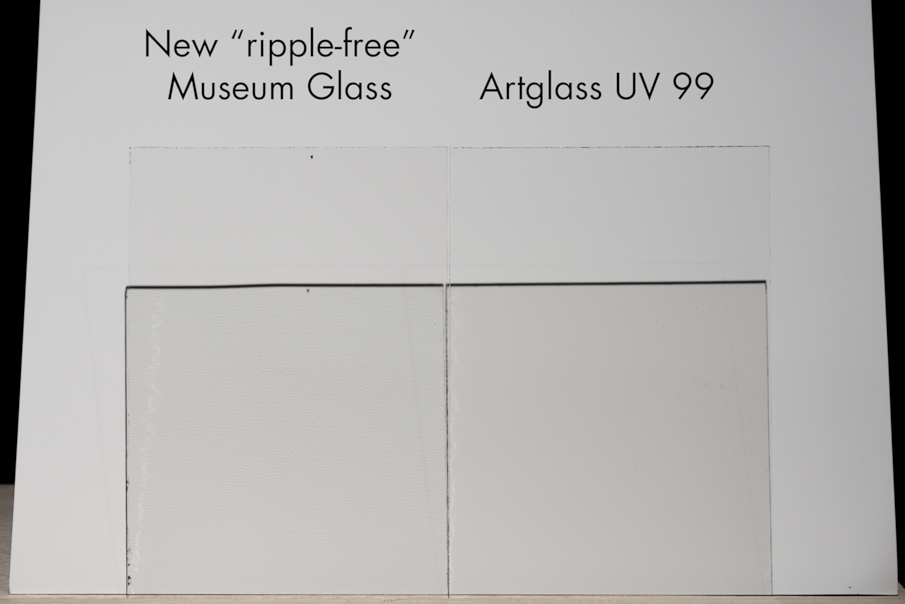
New Museum Glass vs Artglass UV 99 coating ripples casting shadows comparison
Artglass UV 99 and new Museum Glass
Both products have largely similar specifications: AR coatings resulting in less than 1% reflection, 99% UV filtration (from 280nm-380nm for Artglass UV 99 and from 300-380nm for Museum Glass) and similar glass thicknesses, the standard products are 2mm for Artglass and 2.5mm for Museum Glass. The base substrate is regular soda lime float glass rather than low iron glass. The UV absorbing coating is an orangey-brownish color so when combined with the aqua green color of regular glass, they balance each other out resulting in a visually more neutral transmission color. Using low iron glass does increase the overall transmission a little but since it is so neutral, adding the UV coating makes it look overly yellowish in tint. The transmission rating for both is ~97%, though AR glass with lower UV protection ratings tend to have better transmission ratings, up to >99%.
Both manufacturers also claim to have no rippling pattern in their coatings. The previous version of Museum Glass was plagued by quite serious ripples in the UV coatings, which became even more obvious under non-diffused light sources. Let us first investigate these claims.
I placed a sample of each glass under a SORAA MR16 LED light, against Canson Rag Photographique paper. At the base of the image, the paper is touching the glass, and it slants away towards the top, about 3cm away from the glass. The illumination is striking the glass at about 30 degrees to the surface. If the coating has any ripples, wavy shadows will become visible on the paper, with greater distinction as the spacing between it and the glass is increased towards the top. It is a bit difficult to see much at this image size, so here is a close up:
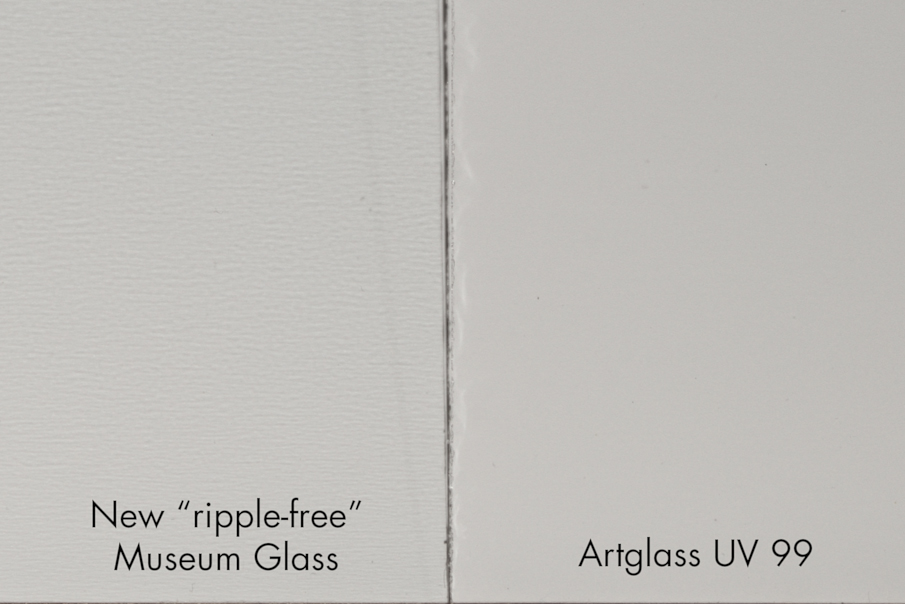
New Museum Glass vs Artglass UV 99 coating ripples casting shadows comparison (close-up)
Unfortunately we see some faint waviness in the shadows cast by the new “ripple-free” Museum Glass coating, while Artglass UV 99 is perfectly smooth. The ripples are about 1mm wide. When Museum Glass is used on top of an over-mat (8 ply thickness being worse than 4 ply) or worse, in a shadow box frame, I find the rippling pattern objectionable. The further away the glass is from the artwork, and the more directional the illumination, the shadows that the rippled coating casts appear more severe and visible.
Now let’s look at the same test done with the new “ripple-free” Museum Glass and the previous version (old) Museum Glass.
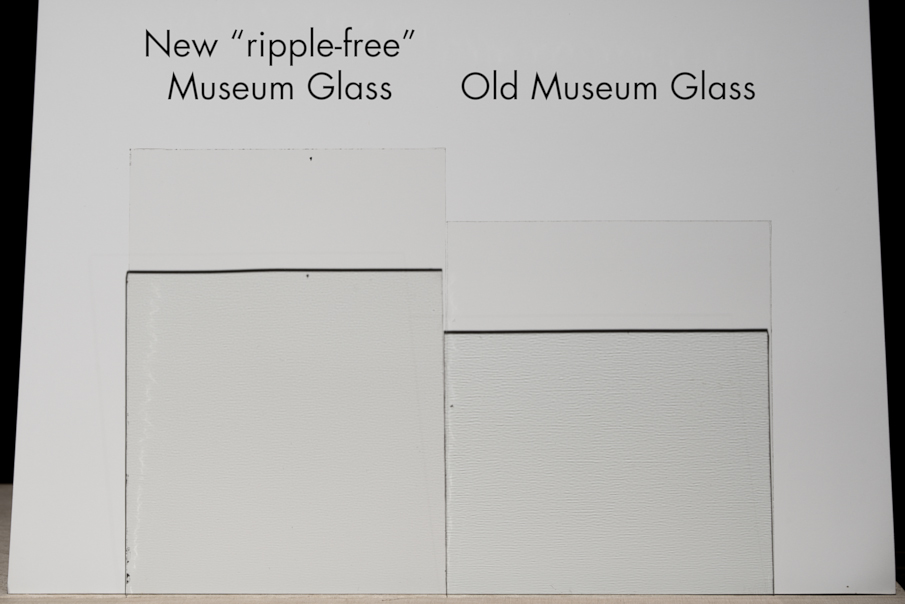
New Museum Glass vs old Museum Glass coating ripples casting shadows comparison
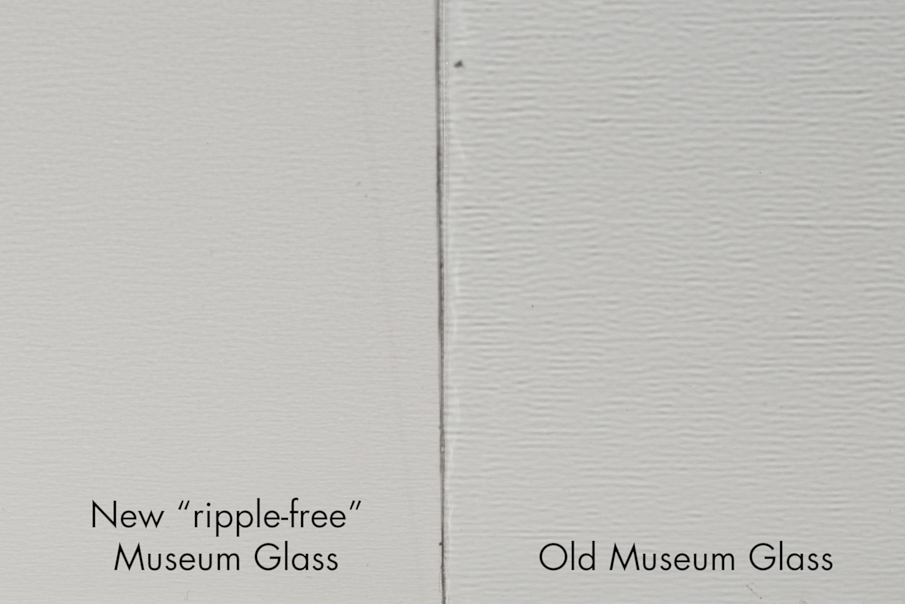
New Museum Glass vs old Museum Glass coating ripples casting shadows comparison (close-up)
Clearly we see that Tru Vue has indeed improved the new Museum Glass coating significantly. The width and depth of the ripples are less and the shadow pattern indicates as such. However the new glass is not totally free of ripples. Tru Vue claims that the new glass has “no visible ripples”. This is not true. When I look closely at the surface of the coating, even though it is much harder to see the rippling pattern, I can still see it in specular reflections on the glass.
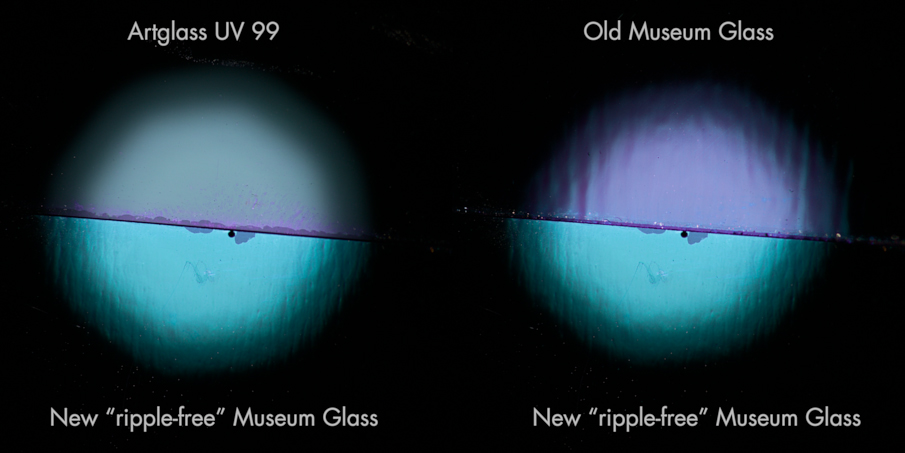
Artglass UV 99 vs new “ripple-free” Museum Glass and old Museum Glass ripple pattern in specular reflection on glass surface
This is a close up photograph of an LED spotlight on Artglass UV 99 placed beside the new “ripple-free” Museum Glass, and the latter with the older version. The split line in the center denotes the edges of the two glasses. The rippling pattern in the old Museum Glass is extremely visible, while the new Museum Glass still has some slightly visible wavy patterning. In comparison, Artglass UV 99 is perfectly free of any patterns in the coating. Simply outstanding.
Now we shall look at the performance of their AR coatings.

Museum Glass versus Artglass UV 99 reflection comparison on Canson Rag Photographique paper
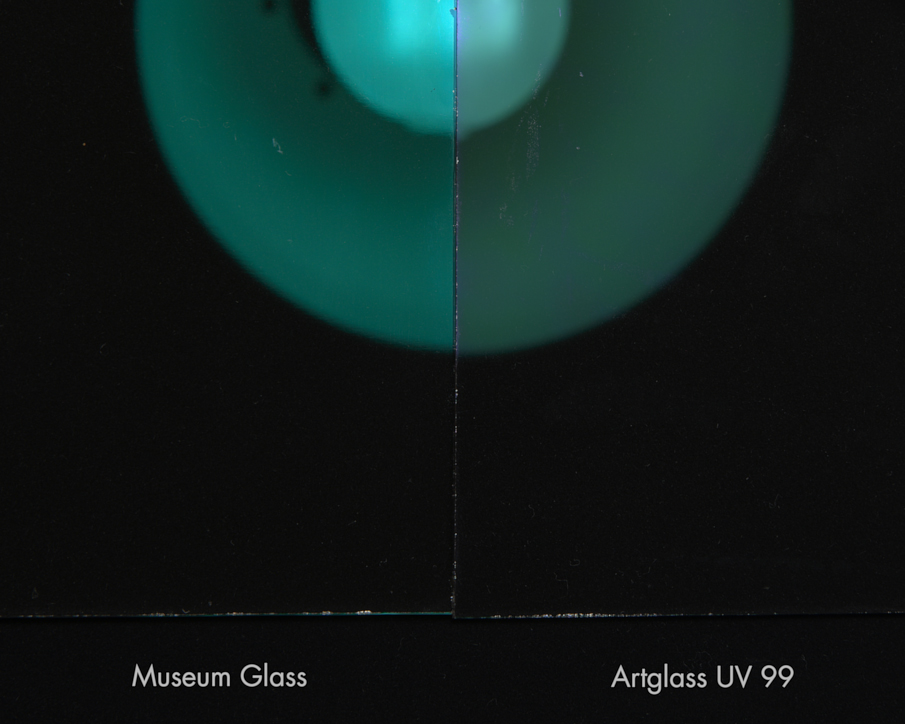
Museum Glass versus Artglass UV 99 reflection comparison on Protostar flocking material
I placed Museum Glass and Artglass UV 99 side by side first on Canson Rag Photographique paper, and positioned a tungsten bulb directly over the surface of the glass. Then I swapped out the paper to Protostar flocking material which absorbs over 99% of light. Reflections are more obvious over darker surfaces, and it makes evaluations easier. In both instances Artglass UV 99 performs better. Also observe that Museum Glass has shifted the hue of the paper very slightly towards red while Artglass is only making it appear slightly yellower. A yellow tint is expected from any 99% UV filtering glass, since the shorter wavelengths near violet are being attenuated. Artglass UV 99 has lower reflections and a more neutral transmission color than Museum Glass.
At oblique incident light angles, the coating reflection color of Artglass UV 99 goes from green to neutral, while Museum Glass shifts from green to red (reflection band shifts to longer wavelengths). See below for photographic examples of the coating reflection color shifting. This means that the transmission band of Museum Glass must therefore shift to shorter wavelengths. When viewed at an angle, Museum Glass appears to have an aqua-cyan transmission color. It is a weird sort of split-personality. In one instance when discussing the color of these glasses with a friend, he saw Museum Glass imparting a greenish tint while I saw a reddish tint. It was exactly due to the coating shifting in hue at different angles which caused this phenomenon.

Transmission shift of Museum Glass to green at an angle
Anti-reflection coatings reflection performance comparison
Finally we come to the big comparison of AR coatings from the other manufacturers of AR glass. The top image shows the reflection brightness and color with the illumination and viewing perspective directly above the glass, where the AR coatings are designed to be at their most effective. The bottom image shows the same but the illumination and viewing perspective are both about 25 degrees from the surface of the glass, to detect if any hue shifting in the coating reflection color occurs. The camera was manually set to produce exactly the same exposure and white balance for all images in the same set, which were then cropped to show only the reflection of the lamp. The 25-degree images were uniformly given less exposure so the highlight details would not blow out. Reflections on AR glass are much brighter at an angle as the effectiveness of the destructive interference effect decreases. The glasses have been grouped differently in each image based on their performance, to make side-by-side comparisons easier. But be careful when making cross comparisons between both images, as the glasses are all in different positions.
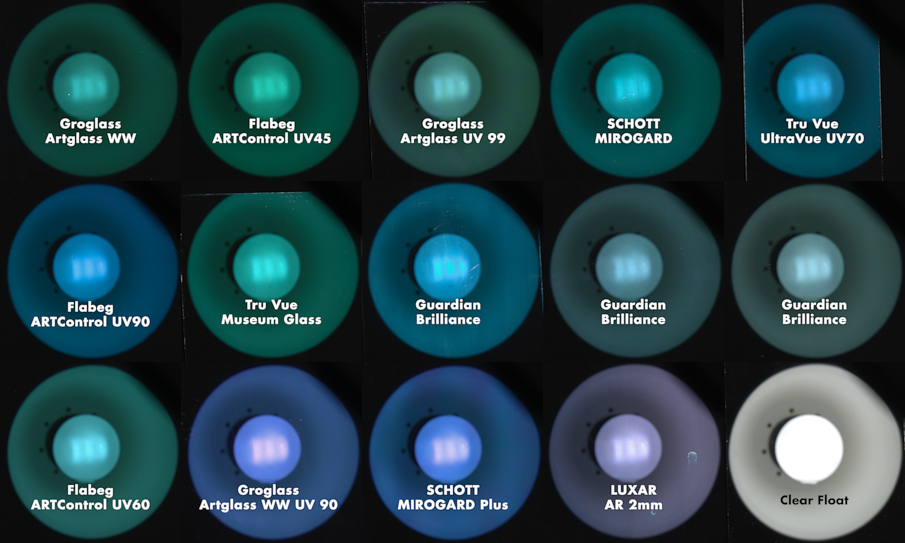
Anti-reflection coatings comparison, tungsten bulb 90 degrees and viewing perspective 90 degrees to surface of glass, on Protostar flocking material.
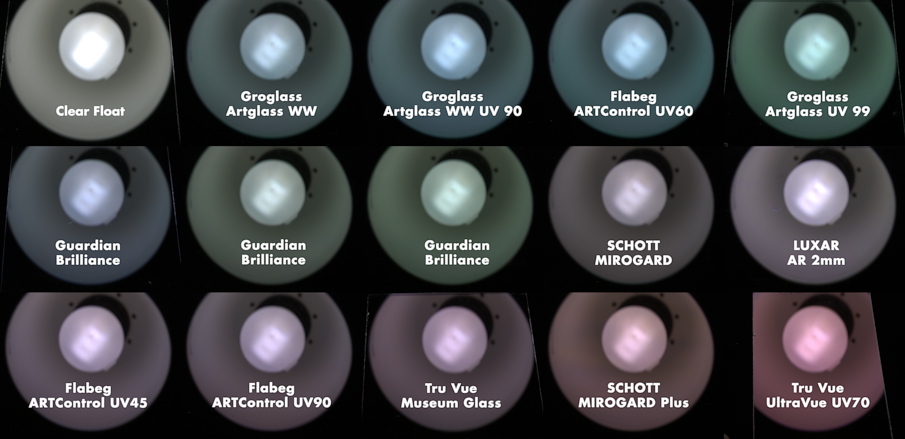
Anti-reflection coatings comparison, tungsten bulb ~25 degrees and viewing perspective ~25 degrees to surface of glass, on Protostar flocking material.
At 90 degrees, all AR glasses reflect significantly less light than regular clear float glass. They all have a non-neutral reflection color, which is a natural characteristic of interference-based AR coatings. Most have a greenish reflection color, while some have a bluish color and some are blue-violet. Groglass Artglass WW leads the pack with the lowest reflection. Flabeg ArtControl UV60, Guardian Brilliance, Groglass Artglass WW UV, Schott Mirogard Plus and Luxar AR all have about the brightest reflections. The rest are about the same visually, with very subtle differences only visible in side-by-side comparisons.
At 25 degrees, we can clearly see if any of the AR coatings have the nasty problem of shifting their reflection band to the longer wavelengths, reflecting red rather than a more neutral tint. Clear float is obviously going to be neutral, and is the reference standard for all the AR glasses. Also note the original reflection color at 90 degrees of each AR glass. Some residual color tint may remain, which is fine. Shifting to a completely different color is not. Groglass Artglass WW, Groglass Artglass WW UV 90, Groglass UV 99, Flabeg ArtControl UV60, and Guardian Brilliance all shift beautifully towards a neutral tint. Schott Mirogard and Luxar shift slightly towards red. Flabeg ArtControl UV45, Flabeg ArtControl UV90 Tru Vue Museum Glass and Schott Mirogard Plus all shift towards a stronger red, while Tue Vue UltraVue UV70 shifts to an even stronger red still.
Notice that some of the AR glasses that have low reflections have the hue shifting problem, while some that do not reflect a little more light. Only Groglass Artglass WW shows exceptional performance in both areas, and also Groglass Artglass UV 99, though with marginally brighter reflections.
Flabeg ArtControl UV90 unusually has very low reflections for a high UV protection glass, when compared to Groglass Artglass WW UV 90 and Schott Mirogard Plus. These all employ interference-type UV coatings. However it is let down by the coating shifting to red problem. Interestingly, their UV60 glass does not exhibit the red shifting problem but it is designed to be more economical product with low AR performance.
As with all things, it is impossible to manufacture something perfectly identical over and over again.AR coatings do vary across batches, sometimes quite significantly. The coating reflection color can range from blue to green, and reflect more or less light. The sharper-eyed readers will notice that I have three Guardian Brilliance glass samples in the mix (the order from left to right in both images are unchanged), which show just this problem. I happened to receive quite a number of samples of this glass and found that they all have very different AR reflection colors. No manufacturer is free from this issue, though in this case is maybe a bit extreme. I note that Guardian markets this glass as having a blue reflection color.
Conclusion
Groglass Artglass WW remains my top and only choice for AR glass, if maximum visual performance is desired, and UV filtration is not required. Happily, it happens to also be the lowest priced AR glass, depending on which part of the world you are in. I highly recommend it.
If UV filtration is required, Groglass Artglass WW UV 99 is now the best option. It has the best AR coating on the market and is truly ripple-free, unlike Museum Glass. In a casual scratch test, I found it the more durable of the two. Cleaning the glass is also relatively easy, though Museum Glass is not worse off in this aspect after Tru Vue revised the coating back in 2014. I will not consider Museum Glass because I feel cheated by the manufacturer’s claim of it being ripple-free, in addition to the inferior AR coating and hue-shifting problem, causing the transmission to shift in color.
Samuel Chia
2 July 2017
Revised: 23 Jul 2021
Disclosure
I am not a representative or seller for any manufacturer or distributor of any of the above-mentioned products. I do not receive any remuneration for my recommendations. All my samples have been provided for free to me through the manufacturers’ own marketing program, through which anyone from anywhere can request for these complimentary samples too. I am not a custom framer nor do I sell any of these products through my own business. I pay fair market prices to my local framers for these glasses and for their custom framing products and services, and my choices are dictated by product performance and value, and also my clients’ requirements and preferences.
One Comment
Comments are Disabled

[…] justify it for my own work, nor recommend it to my clients. UPDATE: This is no longer the case. Groglass has since introduced Artglass UV99, which is better than Museum Glass in several significant […]